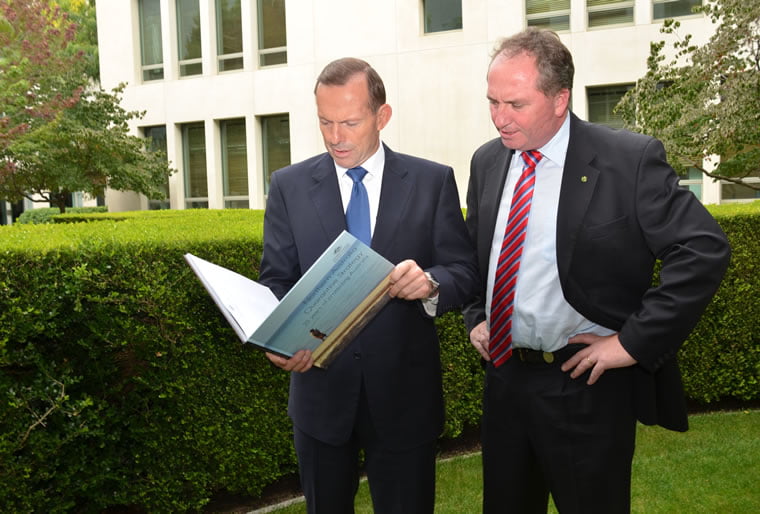The long awaited Agricultural Competitiveness White Paper does a far better job than the Government’s earlier Industry Innovation and Competitiveness Agenda in recognising the role for ICT innovation in Australian competitiveness, but only just.
Both talked of the need for economic infrastructure. The broader Agenda consigned the NBN to an observation that government had “recalibrated the National Broadband Network to use the most cost effective technology to allow a faster and more affordable rollout.”
The agriculture paper is far more prepared to recognise the importance of the NBN noting “The Government is also making an equity investment of $29.5 billion towards constructing the NBN. The NBN will deliver access to fast, reliable and affordable broadband services to rural Australians.”

When the competitiveness agenda was released, it was criticised for not including ICT. Five sectors were selected for the development of growth centres: food and agribusiness; mining equipment, technology and services; oil, gas and energy resources; medical technologies and pharmaceuticals; and advanced manufacturing.
The agriculture paper has noted a couple of the commonly cited projects of ICT in agriculture, including Sense-T and the Kirby SMART Farm.
“The NBN has also transformed the way Kirby SMART Farm in Armidale, New South Wales operates. The NBN has allowed the introduction of modern farming techniques and technologies including:
• remote monitoring of soil moisture levels and environmental conditions;
• low cost wireless tracking systems to understand livestock activity;
• improved farm efficiency through video monitoring of key equipment; and
• instant high-quality communication with experts around the world.” (Agricultural Competitiveness White Paper P.72)
“The Government’s investment in the National Broadband Network (NBN) will mean advances in digital technology are available to all farmers. The Sense-T project is a good example of the benefits of advanced communications technology. Sense-T is helping to build an economy-wide sensor network and data resource in Tasmania, creating a digital view of the state and giving industry, governments and communities the tools to solve practical problems and make better decisions.” (Agricultural Competitiveness White Paper P.96)
It is a pity, however, that the cases mentioned continue to be the SMART farm and Sense-T. These have been the exemplar projects for some time; both featured in the CSIRO’s paper Smart Farming: leveraging the impact of broadband and the digital economy reportthat was released just over two years ago.
Both are applications of monitoring and sensing technologies, including tagging livestocks to determine where cattle graze. The data itself is then used for analysis to improve the predictive value of the data generated.
But the application of ICT goes beyond just remote monitoring and sensing. Agriculture is ready to capitalise on robots and drones to monitor crops. Very large helicopter drones, including the Yamaha RMAX, are already used for seeding and spraying.
In an all too familiar story the Australian start-up Flirtey, which has focussed on delivery, has decided to relocate to the US and restrict trials to New Zealand. This decision is in part prompted by the collaboration offered by the University of Nevada in Reno.
All is not lost, as Swarmfarm is still developing agriculture robotics with the vision “But what if we stopped making things bigger and just made them smarter? What if that little engine that could … became the machine that did? This is what drives us. We know robotic technology holds the key to the future of farming and we want to bring it to you.” And pleasingly it is in collaboration with QUT and the University of Sydney.
As part of the Farming Smarter plans announced in the paper the Government “is also updating the rural RD&E priorities to better reflect industry and community needs. The new priorities will include a stronger focus on advanced technology; biosecurity; soil, water and management of natural resources; and the adoption of R&D.”
Australia’s army of innovators has an opportunity to influence that program to create ICT opportunities in growing our agriculture industries.
Really eager types can enter the Westpac Innovation Challenge (in conjunction with Blue Chilli) and aim to win the $40,000 on offer for “the entrepreneur that creates the most useful and innovative digital solution for Australian agricultural producers and agribusinesses.”
There is a lot more that can be achieved. All the applications referred to – environmental sensors, livestock tagging, drones and robots – are all subsets of the Internet of Things. Australian IoT researchers can profitably turn their minds to the challenges of providing communications to broad acre farming.
A continual effort to roll out standard mobile telephony infrastructure is likely to be a highly inefficient way to achieve ubiquitous coverage.
Do you know more? Contact James Riley via Email.

